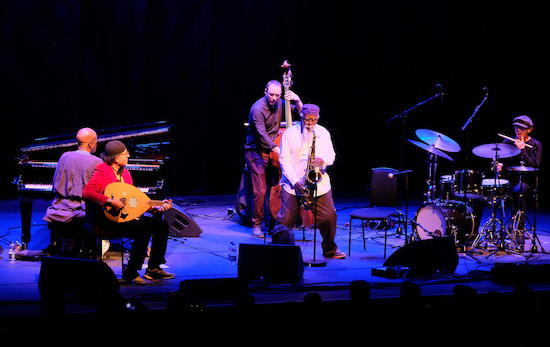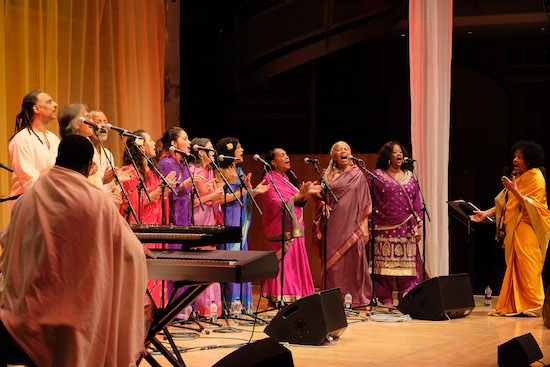They open with ‘Sivaya’, from Alice Coltrane’s 1977 album Transcendence, written a decade after her husband’s death and a few years before she moved into her ashram. Ten singers, dressed in beautiful bright colours, are on the stage with their choir leader, the band leader on synthesizer, and a drummer with a tambourine. We’re in a church, St Luke’s on Old Street, and the Sai Anantam Ashram Singers are here with the bhajans and kirtans written by Coltrane. If you’d gone along to the Sunday service at the California ashram she founded in the 1980s (and all were welcome), you would have been led in your chanting by one of the great jazz musicians of the 20th century – one of the great musicians of any time. The devotional songs she wrote for the ashram were recorded and distributed on cassette among the local community, and some of them were compiled and released earlier this year, with the blessings of Coltrane’s family, on Luaka Bop records. Now the ashram is closed; members and friends, singers and musicians, are travelling the world and sharing this extraordinary music.
“Please remove your shoes,” it says on the little printed guide we’re given. “Do not feel you have to join in.” We do join in though, or some of us do, when the choir leader – Radha Botofasina – looks to the audience (the congregation) and lifts her arms to us, expectantly. I don’t know the words, which are in Sanskrit, so do my best, a bit like when I’m at a church wedding or funeral and can only manage snippets, a syllable here, a mis-timed ahhh there. I’m reminded of that ‘Hey Jude’ backing track where you can hear Linda McCartney singing out of tune – some people mocked it, but I love Linda McCartney and loved her screechy gusto.
The ashram singers, though, are wonderful. Shyam Reyes sounds (and looks) a bit like Michael McDonald, although his voice is richer and happier. When Michelle Coltrane (Alice’s daughter) solos on ‘Om Shanti’ it is tender and strong; Indian classical and jazz singer Sandhya Sanjana steps forward for a delicate, almost tentative raga. Radha is in charge, conducting the singers, pointing out the soloists in turn; she has a Madonna mic and a strong, kind gaze. She also sings, and she talks about her love and gratitude for Alice Coltrane, and leads a call and response with the audience. Who knew a call and response could be moving, so warm and gorgeous? Her son, Surya Botofasina, welcomes us – Om Shanti – and introduces the songs: “You can join in on this one, easy: it’s just ‘Rama Rama’.” Each one of the singers and musicians on the stage has that look of open, strong, kind people – like the lovely cheery staff in Neal’s Yard Dairy, I think to myself, and like the Quakers I met at a friend’s wake a decade ago. God (no pun intended), I am struggling to find my feet here, culturally and epistemologically, but it feels good. I remember my yoga teacher years ago told the class, when some of us weren’t sure about ommmm-ing: chanting is like boiling water at 100 degrees – you don’t have to believe in it, just do it and it’ll work anyway.
The chanting, the repetition is beautiful. The voices, each distinct and lovely, the clapping, the smiles. Happy-clappers, I think, and remember the Christian guitar player who visited us at school assembly once, who made no impression whatsoever. I’d have been impressed by this lot. The bandleader plays glorious synth, cosmic sounds stretching and soaring, swelling and whooshing.
About half way through the event, my friend grabs my hand, excited: “I wasn’t expecting them to play this!” Then I realise that I recognise the music too, because this is ‘Journey To Satchinadanda’, the version of ‘Journey In Satchinadanda’ that Coltrane made in the ashram. It has the gliding, circular organ, a loosening of the original melody, and gliding, circular lyrics – a mantra, this time in English: “Our journey’s end is our journey home / Our journey home is our journey’s end.”
It’s not very spiritually generous of me, but I’m reminded of some joyless Dawkins-y blokes I spoke to recently on social media who told me I’m irrational because I don’t agree with their dismissal of all religion as “worshipping sky fairies”. I told them to fuck off but Alice Coltrane would have had a better response, I bet.
I’m also thinking about Coltrane’s love for the Wurlitzer organ, which allowed her meditative music to never end, to stretch across time and space, to come back around, and her harp which reminds me sometimes of Dorothy opening the door into Oz or Alice tumbling into Wonderland. I’m thinking about John Coltrane’s sprawling dissonant playing, the way he too expands and circles back and creates something where you begin to trust that there are patterns and energies long before you can hear or know them. It is, in fact, cosmic. You don’t have to be sure about everything, I remind myself, you don’t have to prove you’re right or have a brittle, watertight argument. Not at the London Jazz Festival, and not even on Twitter.
I trust my instincts, I trust my first principles, I trust jazz and I trust Alice Coltrane. I don’t have to believe in it, I don’t have to understand it, I’m just going to sing along.
Epilogue
I went to see the Ashram Singers at St Luke’s for both their shows, morning and evening, and I sang a bit more (and cried a bit less) the second time. Then I went to see Alice and John Coltrane’s friend Pharoah Sanders that night at The Barbican. He was silent a lot of the time, sitting on his chair in the middle of the stage, tapping his foot, sometimes, as the others played. He would lift his saxophone then put it down again. He would look at a nearby microphone, as if he might move it a bit closer to his chair, and then he’d close his eyes again. When he got up, it was very very slowly. He played fragments and phrases from ‘A Nightingale Sang In Berkeley Square’, from ‘Olé’, from ‘The Creator Has A Master Plan’. It was transcendent and startling, and almost terrifying because you didn’t want him to stop but you started to realise he would, that he would sit down again and take a rest when you just wanted him to keep playing. But then he would slowly slowly get up and play again. At one point he danced, got right down and right up, played his sax. The creator has a master plan, I thought, maybe, and who am I to argue with Pharoah Sanders, or maybe we’re all getting old and creaky but we still are every bit as wonderful as we ever and always were.

Photos by Mark Allan


